
With consistent growth during an entire decade of outstanding student research, faculty mentorship, and well-deserved accolades, the 10th Annual Student Research Day (SRD) at California State University, Dominguez Hills (CSUDH) highlighted an event poised for expansion for years to come.
This year 352 students shared their research throughout the top floor of the Loker Student Union and in the University Library in the form of 237 presentations and posters, making it the largest SRD to date.

Students from a wide array of disciplines were awarded prizes for their research and presentations, and 10 winners were selected to represent the university during the system-wide CSU Student Research Competition later in the semester at CSU San Bernardino.
Presentations and posters were judged by more than 80 CSUDH professors, administrators, alumni, and professionals, including Emily McGruder, coordinator of the Humanities External Degree (HUX) program who co-chaired SRD last year, and judged multiple sessions throughout the daylong event this year.
“Research is a high-impact practice which faculty talk about a lot these days. The best thing about Student Research Day is the value the students get out of learning to verbally express their ideas while finding their voice in front of a live audience,” said McGruder while judging a Humanities and Letters morning session. “We do research not just for the sake of research, but to have some impact, and this is a venue where students get to share that with their peers while clarifying what they’ve learned. It’s also an incredible display of the quality of the teaching at CSU Dominguez Hills and the quality of student engagement.”
During the morning poster session, Ceilique Hatcher, a sociology major, explored some the psychological pitfalls of social media and shared them with interested passersby’s and judges during her poster presentation entitled ”The Anomie of Social Networking: Feeling of Isolation through Facebook.”
“My research found mixed results. In some cases I found that Facebook does cause isolation, but in other ways Facebook nurtures and provides young people a better avenue for finding friends and quality interactions with people,” she said. “The lack of face-to-face communication is the primary contributor to the isolation because people miss out on the emotional and body language cues necessary to communicate fully with someone.”
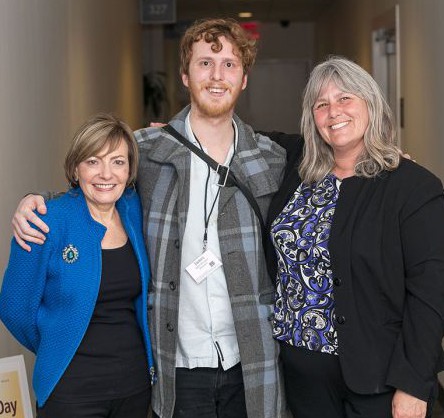
James McIntosh, who is majoring in negotiation, conflict resolution and peacebuilding at CSUDH, provided his investigative research via a PowerPoint presentation called “Art as a Response to Community Conflict.”
His research focused on the Del Amo Superfund environmental cleanup site in Harbor Gateway, the Montrose Chemical Corporation of California’s manufacturing of the pesticide DDT from 1947 until 1982, and the construction of the San Pedro Waterfront Project.
“I found the effected community to be the most fascinating part of my research. There are people who live next to the [superfund] site who are trying to create full and complete lives, even though there are other people who are not necessarily respecting their right to do so,” he said. “The thing that I learned the most is that people will always advocate for themselves, and that awareness still needs to be raised regarding this issue until we reach a tipping point for change to occur. And we’re about to reach that tipping point.”
At the end of the morning sessions, all SRD presenters, judges and volunteers were invited to lunch in the Loker Student Union Ballroom C, which was emceed by Randolph Cauthen, professor of English at CSUDH and co-chair of the SRD organizing committee.
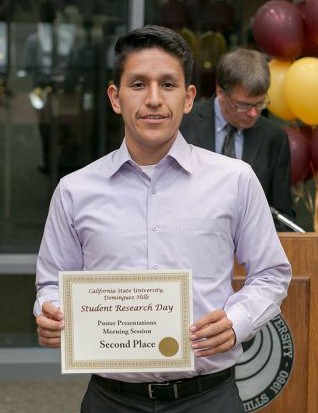
During his remarks, Cauthen invited student presenters to join in on one of the focus groups going on throughout the day to discuss their experiences of not only conducting their research but also presenting it during SRD.
“The reason we do research is to make things better. We research diseases to find out how to cure them. I personally have been researching the Occupy Wall Street movement so we can cure some of the diseases our country has had over the past few years,” said Cauthen to the packed room. “We are also researching how this day [SRD] works, and how your research here at CSUDH works because we want to improve that for you.”
Cauthen also announced the Undergraduate, Research, Scholarship and Creatively Activity office’s first cohort of Student Research Fellows and their $1,000 prize. It was awarded to the student researchers whose work was judged “superior.” The fellowship helps the students “continue their research, scholarship or creative activity.”
Those who attended the lunch were treated to two excerpts from the ballet Don Quixote. Dance student Galina Doty performed a solo Dulcinea variation, followed by students Sarah Cash, Johanne Casio, Keirone Hill, Devin McGee and Doty performing the Gypsy Scene.
Psychology major Andrew Soto, who was awarded one of the fellowships, presented his poster ”Neuropsychological Assessment: Operationalizing ‘Quality of Education’ as High School Rankings Instead of Reading Level” during SRD, and participated in two other presentations. His poster also won second place in the morning session.
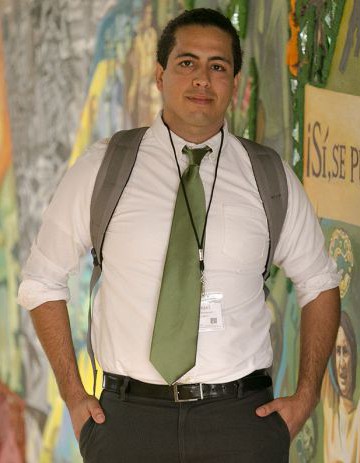
“What an honor. Student Research Day does so much for the students; it’s amazing, has great networking opportunities, and it’s visionary,” said Soto. “It’s very much like a professional conference.”
After lunch, Daniel Hernandez, a health science student, addressed water and farmland conservation, and the pollution reduction benefits of residents growing their own produce at home during his presentation “Using Technology to Grow a Personal Aboveground Garden while in Observation of Southern California’s Drought.”
Hernandez also shared the limitations of his home garden proposal during his research.
“I found that to make significant reductions in the human carbon footprint there would need to be many of these units built and used around the state,” said Hernandez, referring to the raised garden he built at his home to help conduct his research. “I also learned it takes five gallons of water a day to water a fully grown tomato plant, and was surprised by how many miles produce travels on a truck to get to the grocery stories. But planting your own garden is still a positive. In the end, it’s all about empowering people. When you empower the people you empower the community, and a community that is empowered will make things happen.”
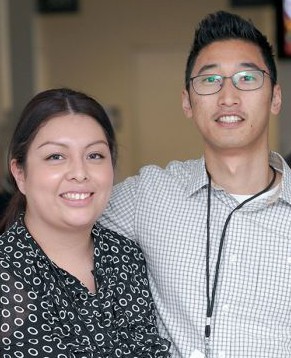
Occupational therapy students Yesiyesa Robledo and Albert You researched “The Lived Experience of Undocumented College Students.”
“I enjoyed the interview process and getting to know the stories of the undocumented students,” said Robledo. “You do the research and do the reading, but when you really talk to someone and learn their struggles it takes on a different perspective and really hits home, especially when you consider a lot of these students didn’t even know they were undocumented until they were getting ready to apply for a driver’s license.”
To cap off the SRD, 42 student presentations were honored during a reception and awards ceremony in the University Library. First place winners received $100, while second place awardees took home $50. The event included live music, brief remarks from Provost and Vice President for Academic Affairs Ellen Junn, and the presentation of awards by John Price, professor of physics and co-chair of the SRD organizing committee.
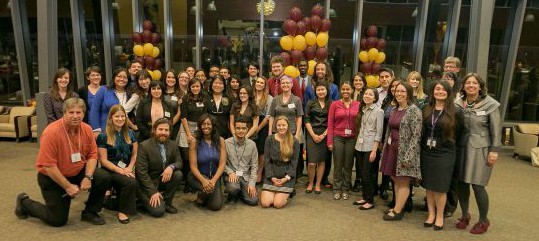
2015 STUDENT RESEARCH DAY SESSION WINNERS
Behavioral and Social Sciences I
FIRST PLACE: Leah Sanchez, Anthropology
Deciphering Cahuachi and the Larger Nasca Culture Complex
Faculty Mentor: Jerry Moore, Anthropology
SECOND PLACE: Sophia DeLaTorre, Claudia Aguilar, Oswaldo Carvajal, Tatyana Kaplan,
and Chadrick Bray, Psychology
Debiasing Perceptions of Forensic Evidence
Faculty Mentor: Heather Butler, Psychology
Behavioral and Social Sciences II
FIRST PLACE: Leah Sanchez, Anthropology
The Impact of New Technology and Digital Culture on California State University,
Dominguez Hills
Faculty Mentor: Ana Pitchon, Anthropology
SECOND PLACE: Stephanie Ellor and Cristina Garcia, Psychology
Situations of Helping Behavior
Faculty Mentor: Heather Butler, Psychology
Behavioral and Social Sciences III
FIRST PLACE: Shalana Bradford, Communications
Instagram: Seeking Self-Acceptance through Selfies
Faculty Mentor: Nancy Cheever, Communications
SECOND PLACE: Ray Jaquez, Psychology
Let’s Talk about Sex(ting): An Examination of Sexting among a Diverse Sample
Faculty Mentor: Keisha Paxton, Psychology
Behavioral and Social Sciences IV
FIRST PLACE: Victoria vanTwist, Marina Armendariz, and Yessenia Magana, Psychology
Obesity-Related Eating Behaviors and Actual Health Status of Latino College Students
Faculty Mentor: Silvia Santos, Psychology
SECOND PLACE: Cynthia Ayala-Munoz and Thomas Foley, Psychology
The Relationship between Exercise, Income, and Behavioral Regulation in Older Adults
Faculty Mentor: Karen Wilson, Psychology
Business, Economics, & Public Administration I
FIRST PLACE: Jasmine Jackson, Business Administration
Bio-Poem: Sam Walton
Faculty Mentor: Gary Polk, Business Administration
SECOND PLACE: Nalleli Reyes, Sarah Shorb, and Wendy Wang, Occupational Therapy
Civilian Employment among Veterans
Faculty Mentor: Claudia Peyton, Occupational Therapy
Creative Arts I
FIRST PLACE: Linda Avila, Art and Design
Paws for a Cause: Victims of Domestic Violence and their Pets
Faculty Mentor: Michele Bury, Art and Design
SECOND PLACE: David Bobadilla and Miguel Huizar, Digital Media Arts
Selfies While Driving
Faculty Mentor: George Vinovich, Digital Media Arts
Creative Arts II
FIRST PLACE: Laura Murphy, Negotiation, Conflict Resolution and Peacebuilding
Power of Personal Practice: 151 Self-portraits and Haikus
Faculty Mentor: Gilah Hirsch, Studio Art
SECOND PLACE: Gabriela Granados, Art and Design
Chicano Murals: Educational Conduits for Future Generations
Faculty Mentor: Marisela Chavez, Chicana/Chicano Studies
Education I
FIRST PLACE: Odeth A. Martinez, Chicana/Chicano Studies and Anthropology
Memorias de Resistencia!: Queer Chicana Voices Challenging the
Myth of Exceptionality
Faculty Mentor: Corina Benavides Lopez, Chicana/Chicano Studies
SECOND PLACE: Joshua Lozano and Jose Franco, Psychology
Student Satisfaction in the Communications Department at CSUDH
Faculty Mentor: Nancy Cheever, Communications
Health, Nutrition, and Clinical Science I
FIRST PLACE: Vicky Chin, Laura Cole, and Lisa Eisenberg, Occupational Therapy
Animal-Assisted Therapy through the Lens of Occupational Therapy
Faculty Mentor: Claudia Peyton, Occupational Therapy
SECOND PLACE: Haley Arnold, Candace Chatman, and Cassandra Duwe, Occupational Therapy
A Phenomenological Exploration: Caring for People with Down Syndrome
Faculty Mentor: Claudia Peyton, Occupational Therapy
Health, Nutrition, and Clinical Science II
FIRST PLACE: Janette Wong, Health Sciences
The Association of BMI with Adolescent Mental Health Indicators
Faculty Mentor: Enrique Ortega, Health Sciences
SECOND PLACE: Ariana LeBrun, Sarah Marrich, and Jonathan Moh, Occupational Therapy
Photovoice Exploration: Meaningful Co-Occupations of Parents of Children with
Autism Spectrum Disorder
Faculty Mentor: Claudia Peyton, Occupational Therapy
Humanities and Letters
FRIST: Melissa Williams, English
Marie De France and Her Subversive Faerie
Faculty Mentor: Debra Best, English
SECOND PLACE: Christine Walker, English
People and Places in Mary Shelley’s Frankenstein
Faculty Mentor: Debra Best, English
Behavioral and Social Sciences V
FIRST PLACE: Jasmin M. Rodriguez, Psychology
Examining Cognitive Functioning and Emotion Regulation in Meditators and Non-Meditators
Faculty Mentor: Tara Victor, Psychology
SECOND PLACE: Christopher Odudu, Aimee Miller, Kaitlin O’Brien, and Lizzette Ceja, Psychology
Differences in Prefrontal Cortex Activation and Executive Functioning
Between Low-Tech and High-Tech Users
Faculty Mentors: Larry Rosen, Mark Carrier, and Alex Lim, Psychology
Behavioral and Social Sciences VI
FIRST PLACE: Aimee Miller and Kaitlin O’Brien, Psychology
The Relationship between Technology Use and the Development of Internet Addiction: Evidence for the Moderating Effect of Executive Function
Faculty Mentors: Mark Carrier and Larry Rosen, Psychology
SECOND PLACE: Jeffrey Rokkum and Jane Jacob, Psychology
Multitasking Across Generations
Faculty Mentor: Mark Carrier, Psychology
Biological and Agricultural Sciences
FIRST PLACE: Ashley Potter, Biology
Bleaching and its Effect on the Competitive Interactions of the Symbiotic Cnidarian, Anthopleura elegantissima
Faculty Mentor: Jacqueline Padilla-Gamino, Biology
SECOND PLACE: Thalia Jimenez, Biology
The Role of BMP4/SMAD/Dusp9 Signaling in the Self Renewal of
Mammary Cancer Stem Cells
Faculty Mentor: Leonardo Martinez, Chemistry
Business, Economics, and Public Administration II
FIRST PLACE: Audrey Ngo, Communication
Missing the Point: How Fox News and MSNBC Politicize Media Coverage of the Michael Brown Shooting in Ferguson, Missouri
Faculty Mentor: Brant Burkey, Communications
SECOND PLACE: Joel Klingenberg, Negotiation, Conflict Resolution and Peacebuilding
Marijuana Legalization: California’s Turn
Faculty Mentor: Margaret Manning, Negotiation, Conflict Resolution and Peacebuilding
Business, Economics, and Public Administration III
FIRST PLACE: Oliver John Baptiste, Sociology
Socioeconomics and Court-Documented Evictions: Urban Sustainability in a
Rentership Society
Faculty Mentor: Matt G. Mutchler, Sociology
SECOND PLACE: Binnae Bridwell, Public Administration
The Deaf and Access to Healthcare: A Review and Assessment
Faculty Mentor: Hugo Asencio, Public Administration
Computer Science
FIRST PLACE: Basil Alhakami, Computer Science
Integrating Data Aggregation and Data Distribution in Sensor Networks
Faculty Mentor: Bin Tang, Computer Science
SECOND PLACE: Setu Taase, Computer Science
Keystroke Rhythm Detection with Graphics Aid
Faculty Mentor: Mohsen Beheshti, Computer Science
Education II
FIRST PLACE: Marlene Cortes, Psychology
The Influence of English as a SECOND PLACE Language on Verbal Fluency Performance
Faculty Mentor: Tara Victor, Psychology
SECOND PLACE: Melissa Merrill, Special Education
What Do You Want? Using Picture Communication Symbols with Bilingual
Preschool Aged Children with Special Needs
Faculty Mentor: Anthony Normore, Special Education
Health, Nutrition, and Clinical Science III
FIRST PLACE: Nick Alvarez-Jett, Erika Borska, and Taryn Erickson, Occupational Therapy
History of Fear of Falling in Community-Dwelling Older Adults
Faculty Mentor: Claudia Peyton, Occupational Therapy
SECOND PLACE: Marina Armendariz, Psychology
Latino College Students Caring for Relatives with Type 2 Diabetes: A Proposal
Faculty Mentor: Silvia Santos, Psychology
Health, Nutrition, and Clinical Science IV
FIRST PLACE: Whitney Baird, Bethany Grigsby, and Eric Carlson, Occupational Therapy
Transgender Identity and the Experience of Transition: A Phenomenological Study
Faculty Mentor: Claudia Peyton, Occupational Therapy
SECOND PLACE: Nasreen Jokhio, Chanmi Ha, and Rebekka Manzella, Occupational Therapy
The Experiences of Adults Practicing Aikido: An Ethnography
Faculty Mentor: Claudia Peyton, Occupational Therapy
Physical and Mathematical Sciences
FIRST PLACE: Warren Nanney, Chemistry
Optimization of Small-Molecule F6: Fullerene Organic Solar Cells
Faculty Mentor: Kenneth Rodriguez, Chemistry
SECOND PLACE: Cassandra Maddux, Chemistry and Biochemistry
Characterizing the Anti-fouling Ability of Thermally Responsive Polymers
Faculty Mentor: Kenneth Rodriguez, Chemistry and Biochemistry
Poster Presentations
Morning Session
FIRST PLACE: Chelsea McElwee, Psychology
Parent-Child Communication and Sexual Behavior in Adulthood
Faculty Mentor: Keisha Paxton, Psychology
SECOND PLACE: Andrew Soto, Psychology
Neuropsychological Assessment: Operationalizing “Quality of Education” as
High School Rankings Instead of Reading Level
Faculty Mentor: Carl Sneed, Psychology
Afternoon Session
FIRST PLACE: Claudio Carini, Michelle Garcia, Brandon Gay, and Martha Ramos, Anthropology
Integrated Geophysical Surveys at Archaic and Formative Archaeological Sites in Tumbes, Peru
Faculty Mentor: Jerry Moore, Anthropology
SECOND PLACE: Lisa Dinh, Chemistry and Biochemistry
Development of a Copper (II) Ion-Selective Electrode Membrane Using Luxol Fast Blue
Faculty Mentor: Barbara Belmont, Chemistry and Biochemistry